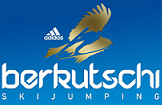The history of ski jumping in summer
on 2008-10-30
From the beginnings on artificial snow and in summer in 1905, over the invention of plastic mattings in the GDR to matts-producers and today's development.
The beginnings on artificial snow and in summer:
The history of snow-substitution, to accomplish ski jumping competitions in summer or in winters with little snow, is more than 100 years old. The athletes tried to jump on a lot of different coatings. It is known, that Norwegian jumpers jumped on hills with coco mats in big tents, while they were on tour with the circus “Busch”. They were – at this time – the biggest attraction. In 1926, an Englishman named Ayscough invents an artificial snow preparation, which made it possibile to make some jumps in London. In springtime 1927, the Germans built an artificial snow palace in Berlin. Youth jumpers from the Erzgebirge jumped 14 meters on that hill.
The young Norwegian jumper Birger Ruud jumped in 1928 in Schildhorn, near to the Havel in Berlin 22 m on a hill, which was coated with fir needles. In the 1930’s, citizens of Berlin formed a ski group called “Pallas”, jumped in the ice palace of Berlin on the so-called “Liliput-Bürstenschanze”. In the French Foreign Legion should have existed a project to test sand skis in the Sahara, but it was never realized. This was in 1931. In the middle of the 1930’s, there was a show competition in a hall of the warehouse “Wanamaker” in New York City, in which a mounted hill with an even coat of borax was tested. At the same time, the Americans tried different coatings like powder, rubber, chips and even cups of almonds. But that was only to look for sensations and not for the value of sports.
In 1938, athletes jumped in the Grunewald of Berlin on a thatched hill in front of a big audience more than 20 meters. In the Austrian Badgastein, the organizers used bark and soft soap as alternatives for snow on a youth competition in 1947. Later, jumpers in Oderwitz (Upper Lusatia) tried to jump on raised spruce needles, whereby they painted the skies with kerosene. At the beginning of the 1950’s, there was the idea to freeze a natural hill. This possibility was given by the technical advances, but it failed, because it was too expensive. Already in the 1930’s the athletes in the United States admired to jump on artificial snow in the big stadiums. After World War II this was a new, but very short trend (see for example the hills of Los Angeles, Salt Lake City, Portland, Racine).
The invention of the plastic mattings in the GDR:
In the whole world, the industrial development of plastic materials was progressed. In 1954, coaches in Oberhof experimented with PVC-boards for the cross-country-training, but the boards were too slippery. Hans Renner, the GDR-ski jumping-coach at this time had the idea to cut plastic boards to threads and to pool them to mats. These mats were pinned on the inrun and on the landing hill overlapping on a wire mesh and because of the flexibility of the mattings and the very good slide-traits after spraying with water, it became a brilliant snow alternative.
The production of the plastic mattings started in Friedrichsroda (Thuringia) in the “Elastonwerk” of the family Saller & Co. The first tests were performed on a small hill in a forest aisle near to Zella-Mehlis without any public attendance. In November of 1954, the world premiere followed at the regional championships in Oberhof on the 40m-youth hill in the presence of 15,000 spectators! After the "Thüringenschanze K82" at Oberhof mastered the challenge, the news of the independence of ski jumping without snow reached the whole world on September 26, 1956. The backup by the patent law had the effect that the plastic mattings became a big export hit for the GDR. The first matting hill in the western world was inducted in 1956 in Bischofsgrün, which is in the Fichtelgebirge. All mattings on that hill were produced by the members of the skiing club by lavishly handwork.
Also in overseas were test projects: In 1960, the American Harbik used in Munising (Michigan) on a small hill brown African natural bristles, which were sprayed with wax. But that worked only for one or two days and was not a steady coating. The projects of the Englishmen to transport natural snow in tons with the ship to London or from the mountains to Manchester were in perpetuity too expensive. So the production of plastic mattings was pushed in the other countries in the following years. In 1968, the first hill was coated with Czech DUROFOL-mattings. This was in Frenstat. The Czech in-house production was a result from the political situation of the Prague Spring. In the years after 1972 existed a modern Czech production in the small Moravian town Chropyne. The engineer Srubar became popular through this business. A lot of hills in more than 12 countries were supplied with plastic mattings. The production continued until 2005. The first matting hill in the USA emerged at the same time in Madison (Wisconsin), where, resulting from the initiative of there club-coach Bill Bakke, plastic scrubbers were manufactured to plastic mattings.
Matting-producers and today’s development:
After the patent laws of the GDR ran out in the middle of the 1970’s, even the West Germans started the production of mattings. The scrubber manufactory of the family Braun & Wettberg in the Hessian Beerfelden was the first, which gained the matting-production and equiped hills in Germany and other countries until 1995. Until the last years the Finnish Company CEL-Lindgren (www.everslide.com) from Porvoo was the dominating company in producing and supplying plastic mattings. Meanwhile, the Italian plastic-host S.I.T. (www.sitecn.com) near to Bologna based on the market. These both companies should be now, regarding to the quality, the leading suppliers for the clubs and associations as the best alternative for mattings.
Since summer 1994, every year the FIS Grand Prix has been taking place on matting hills worldwide. These summer competitions were established and they are accepted by the athletes and the fans as a new alternation at the snowless time. Nowadays, almost every hill in new build projects or renovations gets equipped with the green mattings. The small matting hills are very important for the young jumpers, to enable all-year training.
Parallel to the hill coatings for summer jumping, new technologies for inrun-trails were developed. At the beginnings also plastic mattings were used, but now the jumpers slide – depending of the budget and size of the hills – on ceramic-, glass- or premium steel-trails to the take-off.
Photo gallery:
Advertisement:
Comments:
Matten im Winter
Hallo,
das Skispringen auf Matten ist ja ziemlich weit entwickelt, was mich wundert, ist dass es bis heute keine Skilanglauf-Events auf Matten gibt!
LG, Gü




 Banská Bystrica
Banská Bystrica Altenau
Altenau Eaux-Bonnes
Eaux-Bonnes Chréa
Chréa Oukaïmeden
Oukaïmeden Roa
Roa 




















Post comment: